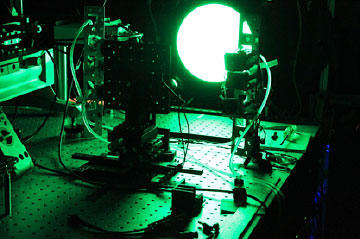Photovoltaic Characterization Laboratory

NIST's PV characterization laboratory is used to measure the electrical performance and opto-electronic properties of solar cells and modules. This facility consists of a monochromator-based dual light source system, an LED-coupled integrating sphere source, a tabletop solar simulator with concentrator optics, a spectroradiometer calibration facility, an RF-based photoconductivity decay tester for charge carrier lifetime studies, and a cell nonlinearity setup based on a flux addition technique.
Specifications/Capabilities
The monochromator setup consisting of two light sources (xenon and quartz-tungsten-halogen), three gratings, a chopper and filters, a custom current preamplifier, two lock-in amplifiers, vacuum and temperature-stabilized stage and other electronics is capable of measuring the power-mode spectral responsivity and external quantum efficiency of any solar cell, including multi-junction solar cells in the spectral range of 300 nm – 1800 nm.
The LED-coupled integrating sphere source is used for irradiance-mode spectral response measurements of solar cells and it consists of a 50.8 cm integrating sphere with a central baffle, a 12.7 cm rear port for incorporating an LED array plate, irradiance monitor ports, light bias ports and an exit port of 22.9 cm for large area illumination of solar cells. The light nonuniformity at the exit port plane of incidence is less than 2 %. The LEDs, ranging in wavelength from 375 nm to 1200 nm, are individually controlled by programmable current drivers and are driven in pulsed mode in a sequential way. The data are recorded by a lock-in amplifier. The results obtained from the integrating sphere measurements are combined with the monochromator based results to construct the irradiance-mode spectral response of solar cells. From this data, the short circuit current of solar cells under the standard reporting conditions are determined.
The minority carrier lifetime apparatus is based on RF photoconductivity sensing of semiconducting wafers. The excitation light source is either a flashlamp or a series of monochromatic high-power LEDs that are controlled by custom power electronics to deliver unique excitation profiles to the device under test. From the measurements of irradiance and reflectance, the charge carrier generation rate is calculated and along with conductivity data is used to calculate the effective charge carrier lifetimes as a function of excitation wavelength and the excess carrier density.
The spectroradiometer calibration station consists of an FEL lamp that is directly calibrated by NIST and is used to transfer the irradiance scale to the spectroradiometers that are used to measure the irradiance of various light sources including the solar simulator, indoor lighting applications (such as LEDs, Xe lamp etc) and for outdoor measurements. The irradiance measurements are also used for spectral mismatch error calculations.
For current-voltage measurements indoors, a large-area flash solar simulator for cell and module testing and a smaller 15 cm single cell steady-state solar simulator are available. The light sources are xenon based and a spectral mismatch correction factor is applied to every measurement so that the results are corrected for standard reporting conditions.

